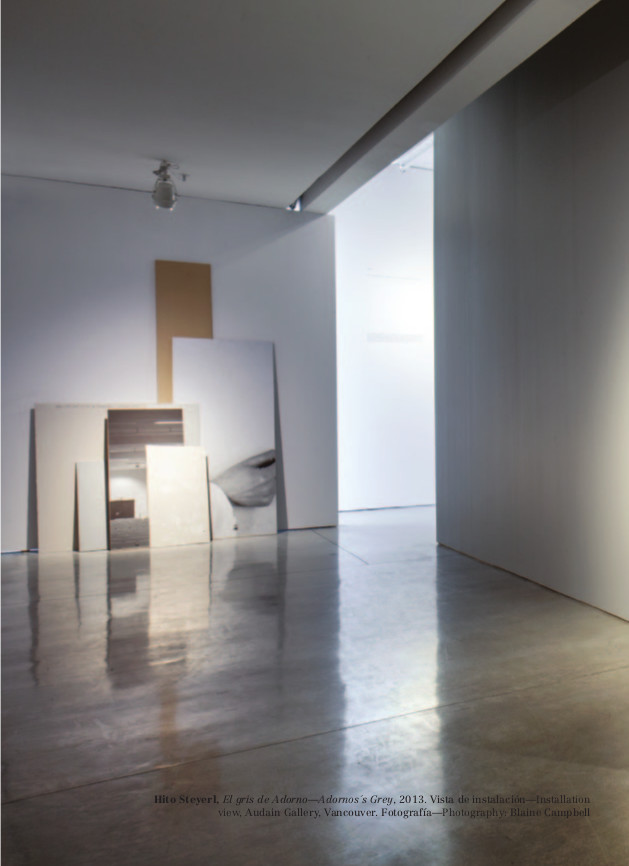Hito Steyerl: Circulacionismo. Circulationism (2014) [English/Spanish]
Filed under book, catalogue | Tags: · art, capitalism, contemporary art, documentary, image, internet, politics, video

“Using video installations and reflection in essays, Hito Steyerl presents a critical apparatus for analyzing the way in which the images produced by television, cinema and contemporary art are inscribed in a visual and economic regime. These are produced, circulated, distributed and consumed in a framework of audiovisual capitalism and form part of different institutional mechanisms of the art world, including the museum. From this perspective, the images are converted into a vehicle of social relations with an ambivalent status insofar as they are both commodity and means of political statement. A second problem raised by the artist is the truth condition of images. Her work repeatedly makes use of appropriated or poor-quality images, together with documentary-type elements, with the aim of questioning the relationship between documentary, reality and representation.”
This book contains Steyerl’s essays “Too much world: Is the Internet dead?” and “Theodore W. Adorno. Timeline”, and the essay “Weather for Liquidity” by Brian Kuan Wood.
Published on the occasion of the exhibition Hito Steyerl: Circulationism held from 27 September 2014 – 1 March 2015 at MUAC in Mexico City which brought together three of her recent works: Adorno’s Grey (2012), Museum as Battlefield (2012) and Liquidity Inc. (2014).
Publisher Museo Universitario Arte Contemporáneo (MUAC), Universidad Nacional Autónoma de México (UNAM), Mexico City, 2014
Folio MUAC series, 23
ISBN 6070257545, 9786070257544
71 pages
Jorge Ribalta: Universal Archive: The Condition of the Document and the Modern Photographic Utopia (2008) [CA, ES, EN]
Filed under book, catalogue | Tags: · archive, barcelona, city, documentary photography, history of photography, photography

“This guide has been published on the occasion of the exhibition Universal Archive. The Condition of the Document and the Modern Photographic Utopia (2008-09) that analyses the idea of a document in the history of photography on the basis of the study and staging of a number of debates about the genre during the 20th century. With the aim of assessing various hypotheses about the meanings and mechanisms of the documentary, it traces a historical itinerary that gets under way with the beginning of the hegemony of photography in the illustrated press in the first third of the 20th century, before arriving at the purported crisis of photographic realism in the digital era at the end of the century. For all that, the exhibition is not a history of the genre, nor does it exhaust its possible definitions, but instead attempts to study how the photographic document has been constituted — in a consistently ambivalent and polemical way — in certain historical contexts. ”
Publisher Museu d’Art Contemporani de Barcelona (MACBA), Barcelona, 2008
ISBN 9788489771703
99 pages
via MACBA
Exhibition reviews: Max Andrews (Frieze 2009), David Evans (Photography & Culture 2010), Art Tattler (n.d.).
Arxiu universal (Catalan, 2008, PDFs)
Archivio universal (Spanish, 2008, PDFs)
Universal Archive (English, 2008, PDF, 3 MB)
Ulay & Marina Abramović: Modus Vivendi (1985)
Filed under catalogue | Tags: · art, performance art

“Between 1980 and 1985, the performance artists Marina Abramović and Ulay collaborated on a series of works in which art, life, aesthetics and ethics combined to create a unified whole. Their performances explored the way the body and mind reacts to extreme situations.
This exhibition was the first to present a wide selection of works by the two artists, from the very start of their partnership. A part of this selection comprised photographs documenting the artists’ journeys through Australia, the US and Asia, where they staged a number of performances with the involvement of the local indigenous peoples. Among these are Conjunction and Positive Zero (both 1983), which examine the relationship between western society and the rituals performed by other cultures. From 1984 to 1985 the two artists produced Modus Vivendi, a series of works shot on Polaroid in which they acted out male and female archetypes.
One of their most important performance pieces is Nightsea Crossing (1982): the artists faced each other for seven consecutive hours and engaged in a psychological battle in which their aggression and competitiveness was sublimated to the point of passivity. Many of the duo’s performances investigate the notion of the symbiotic relationship and the overcoming of one’s own subjectivity, in a situation of balance/imbalance between two opposing forces.” (Source)
Catalogue of the exhibition Modus Vivendi: Works 1980-1985 held at the Van Abbemuseum, Eindhoven, 14 Sep – 13 Oct 1985; Koelnischer Kunstverein, Cologne, 20 Oct – 17 Nov 1985; and Castello di Rivoli, Turin, 18 Apr – 8 Jun 1986. With an essay by Thomas McEvilley.
Prepared by Jan Debbaut
Publisher Van Abbemuseum, Eindhoven, 1985
95 pages
via Bint Bint

